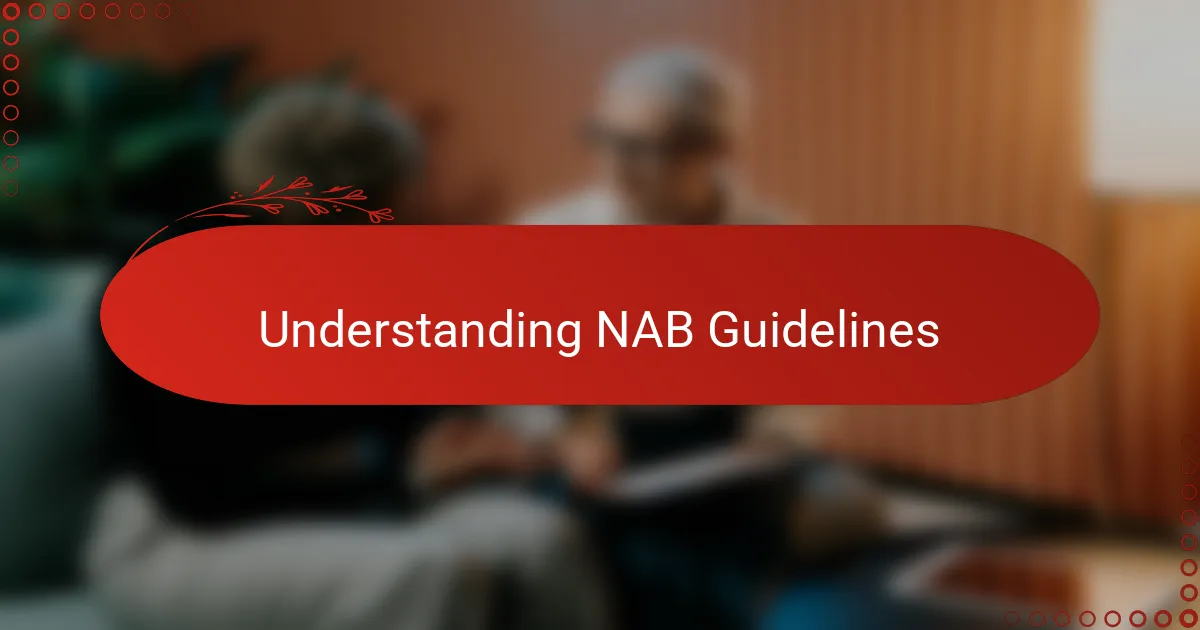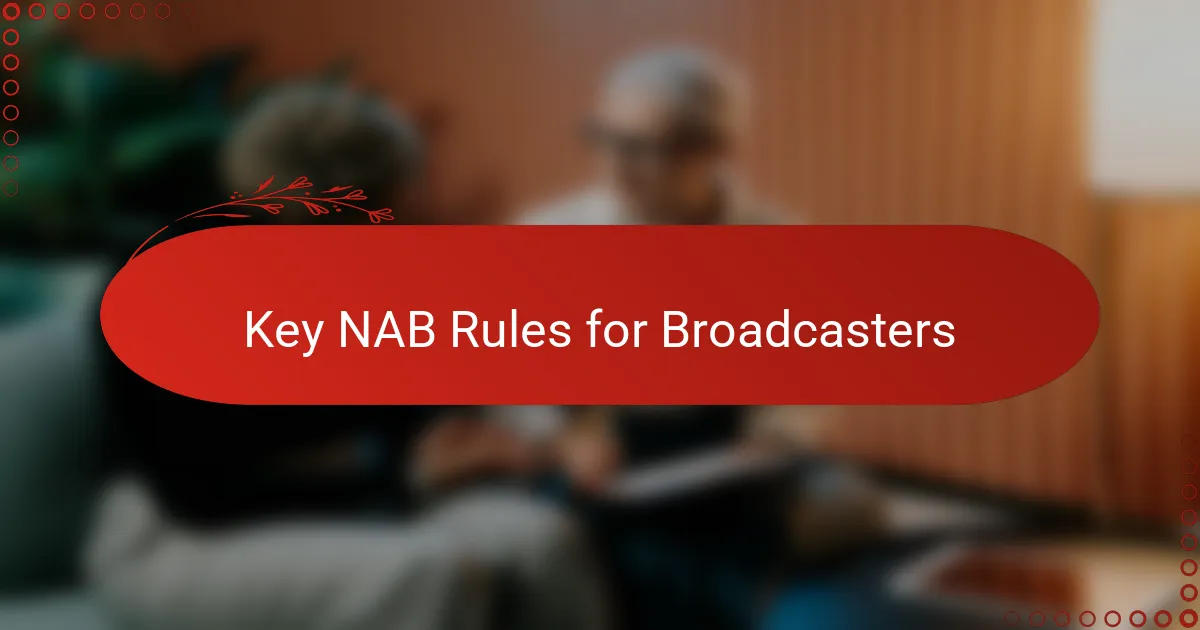Key takeaways
- NAB guidelines are essential for maintaining trust, fairness, and integrity in broadcasting, protecting both audiences and stations.
- Compliance improves transparency and professionalism, fostering stronger connections with listeners and enhancing the quality of broadcasts.
- Regular reviews, team communication, and proactive education help broadcasters navigate compliance challenges effectively.
- Adhering to NAB standards transforms compliance from a mere obligation into an opportunity for creative growth and improved broadcast quality.

Understanding NAB Guidelines
When I first encountered NAB guidelines, I admit they seemed like a maze of rules designed to trip you up. But as I dug deeper, I realized they exist to ensure fairness, accuracy, and respect for audiences—values I personally hold dear in broadcasting.
Have you ever wondered why certain content is restricted or why strict disclosure is required? To me, these guidelines act as a framework that protects both the listener and the broadcaster, creating trust in a medium that can easily lose its credibility without such checks.
Understanding NAB guidelines isn’t just about compliance; it’s about embracing a standard that elevates the quality and integrity of what we put on air. I find that when I align my work with these rules, my broadcasts resonate more authentically and responsibly with my audience.

Importance of NAB Compliance in Radio
Compliance with NAB guidelines is more than just ticking boxes for me; it’s about maintaining the lifeline of trust between the radio and its listeners. Have you ever thought about how quickly trust can fade if even one broadcast crosses the line? Staying within these standards reassures me that I’m honoring the responsibility we have to our communities.
I recall a time when I almost overlooked a subtle guideline about sponsorship disclosures. That small moment made me realize how critical transparency is—not only legally but morally. It’s these details that keep the broadcast honest and listeners coming back, knowing they’re being treated with respect.
NAB compliance also protects the station itself, shielding it from penalties that could disrupt operations. Knowing that following these guidelines keeps everything running smoothly allows me to focus on creativity without the constant worry of unintended violations. Doesn’t that peace of mind make broadcasting even more rewarding?

Key NAB Rules for Broadcasters
One of the key NAB rules that always stays top of mind for me is maintaining clear sponsorship disclosures. It might sound straightforward, but honestly, I’ve caught myself double-checking phrasing just to ensure there’s no ambiguity. Have you ever wondered how listeners feel when they can’t tell where content ends and advertising begins? That transparency builds a bridge of trust that I value deeply.
Another rule that challenges me is the restriction on offensive language and content. I once hosted a lively debate segment that teetered close to the edge, and I found myself constantly filtering my own words before they hit the air. It made me appreciate how these guidelines push us toward thoughtful communication rather than shock value.
Then there’s the obligation to avoid misrepresentation and promote accuracy, which to me feels like the backbone of credible broadcasting. I recall a news piece where verifying a source took longer than expected, but respecting that rule preserved our station’s reputation. Isn’t that worth a bit of extra effort to keep our audience’s confidence intact?

Common Challenges in NAB Compliance
Navigating the maze of NAB compliance often feels like walking a tightrope. I remember once juggling a live broadcast where I had to constantly monitor language and content to avoid any slip-ups. It stressed me out at first, but over time, it shaped my instincts to be more mindful and deliberate with every word.
One challenge I frequently face is interpreting the fine line between creative freedom and regulatory boundaries. Have you ever wondered how much you can push the envelope without crossing it? That balance is tricky, and sometimes, I find myself second-guessing if a segment might unintentionally breach a guideline.
Then there’s the ongoing task of staying updated with evolving rules. I’ve seen colleagues caught off guard by guideline changes announced with little notice, creating a scramble to adjust content last minute. In my experience, keeping a close eye on official communications and frequent team discussions helps me stay ahead and reduces those last-minute headaches.

Strategies to Ensure NAB Compliance
One strategy that’s been a game-changer for me is setting up regular checklist reviews before any broadcast. It sounds simple, but taking those few extra minutes to run through NAB compliance points—like sponsorship disclosures or language checks—has saved me from scrambling under pressure. Have you ever noticed how pausing to double-check elevates your confidence on air? It really does.
I also rely heavily on team communication. When we openly discuss upcoming shows and possible compliance concerns, I find that collective insight often catches issues I might overlook alone. There was a time a colleague flagged a subtle content nuance that I hadn’t considered, preventing a potential violation. Collaborating like this makes compliance feel less like a burden and more like a shared responsibility.
Finally, staying proactive about education keeps me ahead of the curve. NAB guidelines evolve, and I make it a point to participate in workshops and review updates regularly. When rules shift, I feel empowered instead of blindsided, which to me, transforms compliance into an opportunity for growth rather than a chore. Isn’t that approach far more motivating?

Personal Experience with NAB Guidelines
When I first had to implement NAB guidelines during live broadcasts, the pressure was intense—I’d catch myself second-guessing every word to avoid a slip-up. That early tension gradually turned into a habit of thoughtful communication that now feels natural and even empowering. Have you ever experienced that moment when what once felt restrictive becomes a source of creative discipline?
There was a particular instance when I overlooked a subtle sponsorship disclosure detail, and the feedback was immediate. It was a humbling reminder that even small lapses can impact trust, and since then, I’ve made transparency a non-negotiable part of my process. This experience taught me that compliance isn’t just about rules—it’s about respect for the audience and the medium.
Keeping up with frequent updates to NAB guidelines has been another personal challenge. I remember scrambling once after a last-minute rule change, which was stressful but motivated me to develop a routine for monitoring communications more closely. Hasn’t there been a time when adapting quickly turned a potential setback into a chance to improve? For me, staying proactive transformed compliance from a chore into an opportunity to grow as a broadcaster.

Benefits of Adhering to NAB Standards
When I reflect on the benefits of adhering to NAB standards, the foremost advantage that comes to mind is the trust it builds with listeners. Isn’t it rewarding to know your audience feels respected and protected because you follow these guidelines? For me, that trust is the foundation of any meaningful broadcast relationship.
Beyond audience trust, compliance also serves as a safety net for broadcasters and stations. I remember the relief I felt after avoiding a potential penalty by simply double-checking sponsorship disclosures—small efforts like that save a lot of headaches and keep the station’s reputation intact. Don’t you think that kind of assurance frees you to focus more on creativity rather than worrying about unintentional rule-breaking?
Another benefit I appreciate is how these standards encourage professionalism and consistency in content. Knowing that I’m operating within a clear framework challenges me to raise my standards, ultimately delivering programming that’s both responsible and engaging. Have you noticed how that clarity can turn compliance from a chore into an opportunity for growth? I certainly have.
